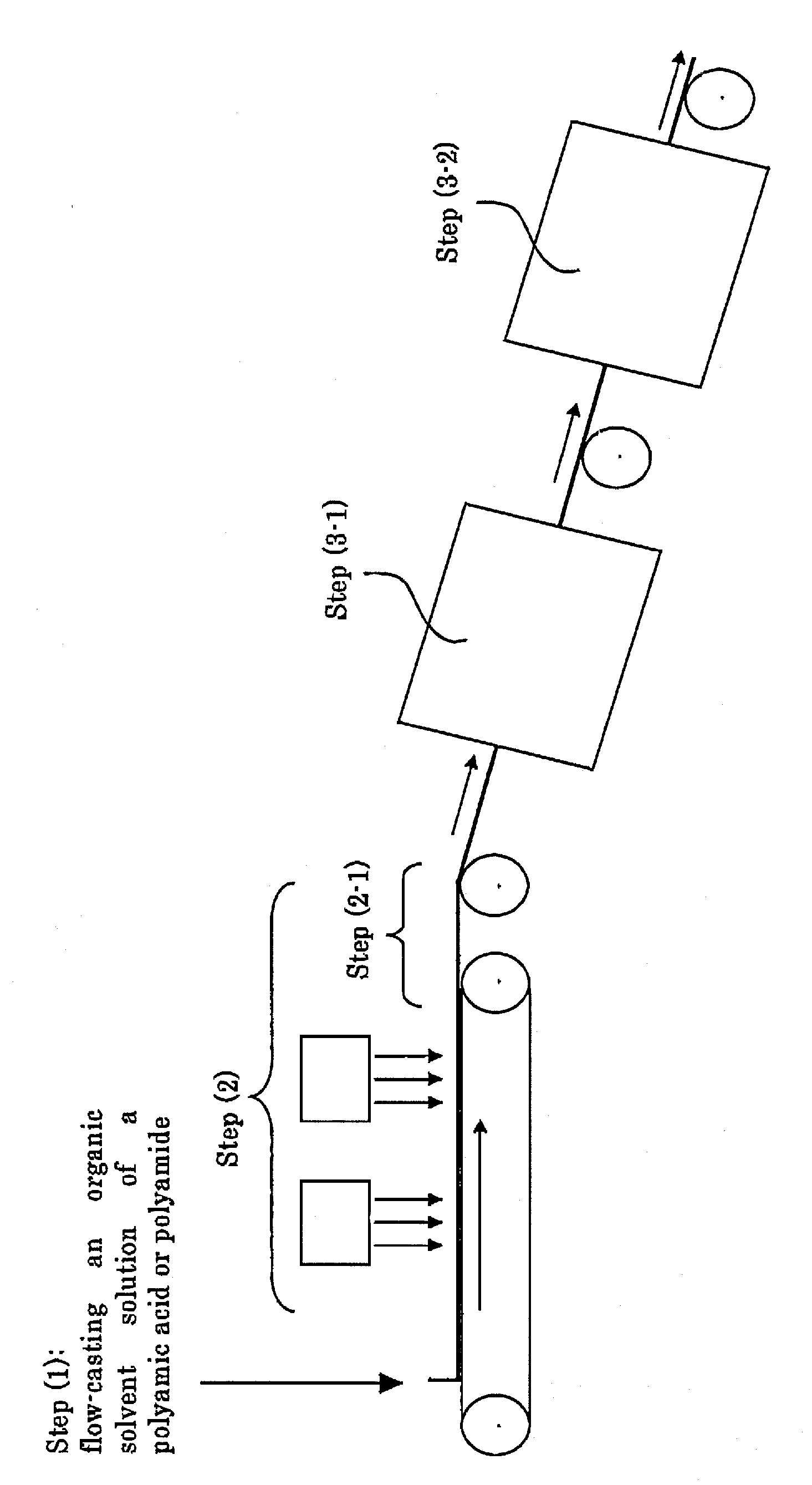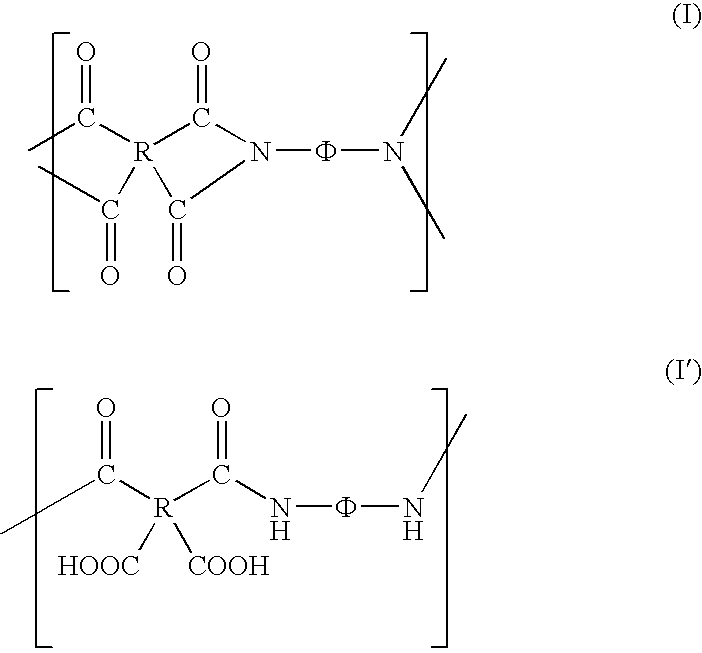Process and apparatus for production of colorless transparent resin film
a colorless transparent, resin film technology, applied in the direction of dielectric characteristics, other domestic articles, coatings, etc., can solve the problems of low birefringence and colorless transparency, insufficient heat resistance, and decrease in total light transmittance of resin film, and achieve excellent heat resistance and flatness, high colorless transparency
- Summary
- Abstract
- Description
- Claims
- Application Information
AI Technical Summary
Benefits of technology
Problems solved by technology
Method used
Image
Examples
reference example 1
Synthesis of 1,2,4,5-cyclohexanetetracarboxylic dianhydride
[0216]22.08 kg (86.88 mol) of pyromellitic acid, 8 kg of a catalyst containing rhodium supported on activated carbon (produced by N.E. Chemcat Corporation) and 80 kg of water were charged in a reactor made of Hastelloy (HC22) having a capacity of 200 L, and the interior of the reactor was replaced by nitrogen gas under stirring. The interior of the reactor was then replaced by hydrogen gas, and the temperature was increased to 50° C. under a hydrogen pressure in the reactor of 3.3 MPa. The reaction was performed for 2 hours while maintaining the hydrogen pressure to 3.3 MPa. The hydrogen gas in the reactor was replaced by nitrogen gas, the reaction liquid was taken out from the autoclave, and the reaction liquid was filtered in a hot state to separate the catalyst. The filtrate was concentrated by evaporating water under reduced pressure with a rotary evaporator to deposit crystals. The crystals thus deposited were separated...
reference example 2
[0218]4.34 kg (12.6 mol) of α,α″-bis(4-amino-phenyl)-1,4-diisopropylbenzene, 1.99 kg (5.4 mol) of 4,4′-bis(4-aminophenoxy)biphenyl and as a solvent 12.5 kg of γ-butyrolactone and 3.13 kg of N,N-dimethylacetamide were charged in a reactor made of SUS316L having a capacity of 60 L equipped with a thermometer, a stirrer, a nitrogen introducing tube and a condenser, and were dissolved with each other, thereby increasing the temperature to approximately 70° C. Subsequently, 4.04 kg (18 mol) of 1,2,4,5-cyclohexanetetracarboxylic dianhydride synthesized in Reference Example 1 was added thereto by dividing into plural portions over 1 hour, and after adding 91 g (0.9 mol) of triethylamine as an imidation catalyst thereto, the temperature was increased to 180° C. to perform reaction for 3 hours while distilling off and recovering produced water.
[0219]After lapsing 3 hours, it was confirmed that the recovered water was 1.095 kg and distillation of water was completed, and then 27.16 kg of N,N-...
example 1
[0221]Step (1): The organic solvent solution of the polyimide obtained in Reference Example 2 was extruded from a T-die with a metering pump in a prescribed amount and flow-cast on a rotating stainless steel belt.
[0222]Step (2): Subsequently, the flow-cast material was dried for 50 minutes while blowing a mixed gas containing 10% by volume of oxygen and 90% by volume of nitrogen heated to 120° C. onto the flow-cast material at a flow velocity of 6.6 m / sec, and further dried for 50 minutes while blowing a mixed gas containing 10% by volume of oxygen and 90% by volume of nitrogen heated to 140° C. at a flow velocity of 6.9 m / sec, followed by being released from the stainless steel belt, to provide a self-supporting film having a thickness of 220 μm. The self-supporting film had a total light transmittance of 89.8%, a YI (yellow index) of 1.74, a haze of 1.10% and a solvent residual ratio of 21.0% by mass.
[0223]Step (3-1): The self-supporting film obtained in the step (2) was passed th...
PUM
| Property | Measurement | Unit |
|---|---|---|
| Temperature | aaaaa | aaaaa |
| Temperature | aaaaa | aaaaa |
| Temperature | aaaaa | aaaaa |
Abstract
Description
Claims
Application Information
 Login to View More
Login to View More - R&D
- Intellectual Property
- Life Sciences
- Materials
- Tech Scout
- Unparalleled Data Quality
- Higher Quality Content
- 60% Fewer Hallucinations
Browse by: Latest US Patents, China's latest patents, Technical Efficacy Thesaurus, Application Domain, Technology Topic, Popular Technical Reports.
© 2025 PatSnap. All rights reserved.Legal|Privacy policy|Modern Slavery Act Transparency Statement|Sitemap|About US| Contact US: help@patsnap.com



